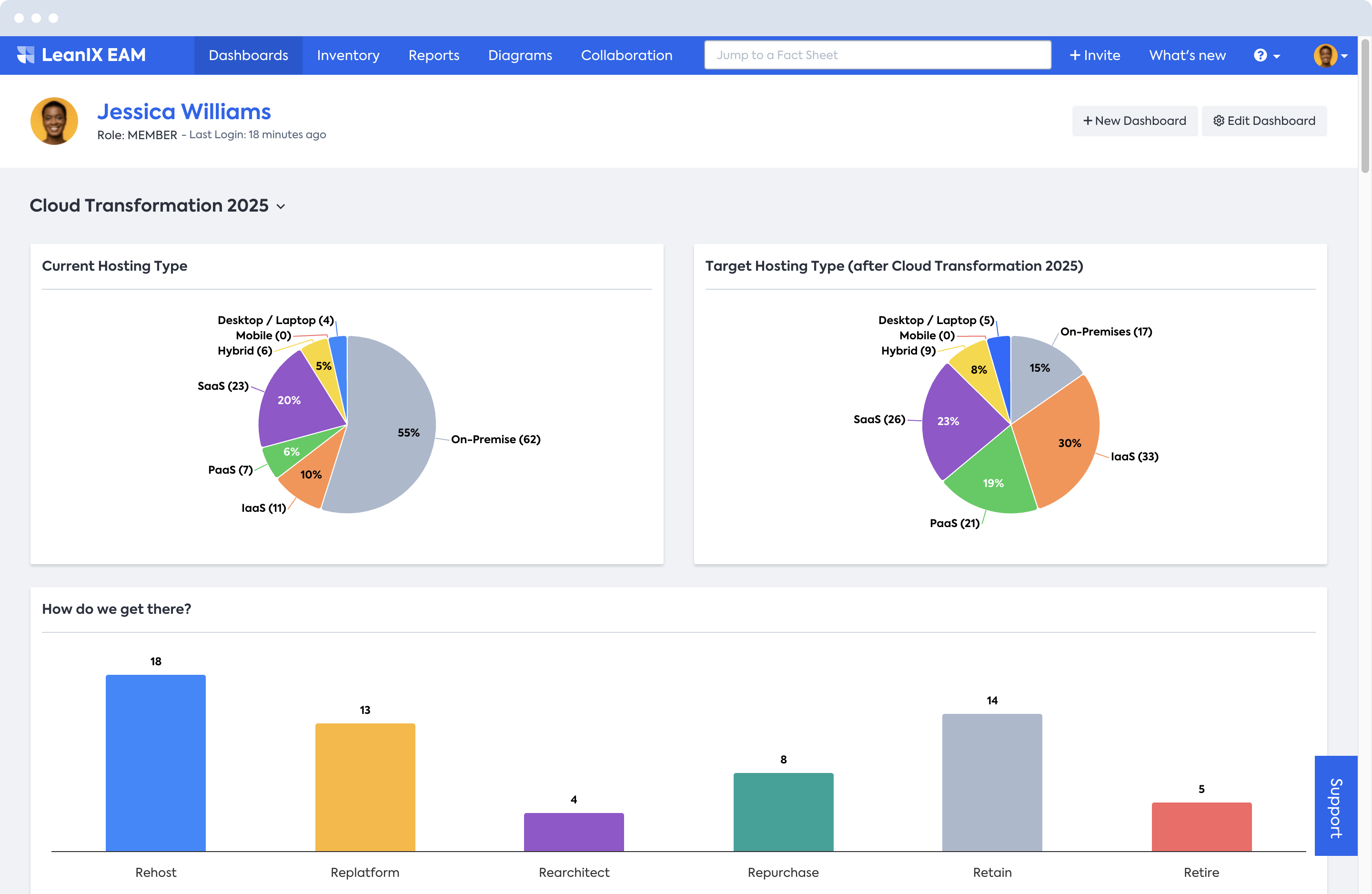
Generative AI is a competitive advantage that many organizations are locked out of by legacy technology. Find out how you can prepare your IT landscape to leverage this innovative new software.
Leveraging generative artificial intelligence (AI) requires not just a technology transformation to adopt AI, but also a pre-emptive transformation to ensure your IT landscape is ready for this innovative technology. These kinds of iterative transformations require gathering and maintaining dynamic information on your IT landscape so you always have clarity on your transformation strategy.
To achieve that, you need to enable your enterprise architects with an enterprise architecture management platform that can document, store, and share this information with your stakeholders. To find out more about how the LeanIX platform can support you with AI transformations, book a demo:
In the meantime, let's look more closely at what generative AI is, why it's important, and how you can prepare your landscape to leverage this innovation.
What Is Generative AI?
Generative artificial intelligence (AI) is a new technology that allows software to generate content at a similar level to that of human beings. Users can simply type a request into the generative AI interface for a piece of content to their specifications and the AI can create images, text to meet those requests.
This means generative AI can be used to almost instantly create reports, summarize information, and produce diagrams and presentations to fit your needs. The Massachusetts Institute of Technology recently reported that AI tools could cut the workload of the average employee by 40% and increase the quality of their output by 18%.
Given that many basic generative AI models are free to use, and even the premium services are inexpensive, this is clearly a hugely important innovation. Yet, this is just the beginning of how generative AI can be used.
Why Generative AI Matters
Generative artificial intelligence (AI) is already seen as a competitive advantage for enterprise. The future, however, could belong to generative AI.
The list of potential use cases for generative AI extends far beyond simply creating reports. Let's look at some of the potential, blue-sky-thinking use cases for generative AI:
Documentation
The arduous work of creating and maintaining meeting minutes, technical documentation, and much more, can all be delegated to AI. This frees up time to focus on making strategic decisions.
Live Translation
Since generative AI tools are trained in various languages, they can instantly translate text in a much more natural way than previous translation tools. Generative AI tools already exist to allow a participant to experience a video call in English when the other party is speaking German, for example.
Virtual Webinars
Taking the above one step further, generative AI can be used to instantly create video and react to live input. As such, a correctly set up AI can create a virtual avatar to host a live webinar to educate participants on a set issue without any input from a human.
Sentiment Analysis
Since generative AI can rapidly summarize written text, this allows it to analyze large data sets for tone. This means generative AI can be used to analyze social media or employee communications to report back on the general sentiment.
Customized Content
Generative AI can detect user preferences based on their internet profiles and instantly customize content for the viewer. On a basic level, this could allow the level of technical detail in marketing content to vary depending on the reader's technical knowledge, for example.
Cyber Security
Computer code is another type of language, just like the traditional languages that generative AI tools have been trained on. As such, generative AI is being used to detect code that could have a malicious intent, even if it isn't similar to known malware.
Software Development
Since generative AI can deal with code as readily as written text, it is capable of creating software applications to user specifications in a fraction of the time. This is already reducing the workloads of busy developers in bug fixing and software creation.
With all these potential uses for generative AI, it's no surprise that businesses are rushing to implement these tools into their IT landscape. However, many organizations are blocked from accessing this technology by their legacy software.
The Consequences Of A Legacy Landscape
Generative artificial intelligence (AI) was only made available to the public in the last 12 months. As such, the technology is entirely based on modern, cloud-native technology.
We know 70% of digital transformations fail, according to Boston Consulting Group research. This means many organizations are struggling to rid their IT landscapes of legacy technology.
As such, it's easy to understand how IT landscapes based on outdated on-premise technology are not compatible with a whole field of technology that was only invented last year. This locks many organizations out of leveraging this essential technology innovation.
Are You Ready For Generative AI?
Generative artificial intelligence (AI) is a key technology and a competitive advantage for companies in the current market. Are you in a position to leverage that advantage?
Legacy technology could prevent you from doing so, but the reverse is also true. In the excitement to get on the bandwagon with generative AI technology, it's possible to over invest in the huge number of tools that have rapidly become available.
The below image from Insight Partners gives an indication of the number of tools that are available across a range of business capabilities:
How many of the above tools could offer a return on investment for your specific organization? Before you begin investing in AI, you need to understand how it will fit into your IT landscape, where it should fit into your IT landscape, and whether it's even possible for it to fit into your IT landscape.
How You Can Prepare For Generative AI
Getting your IT landscape ready to leverage generative artificial intelligence (AI) first requires understanding it. This is where it makes sense to turn to your enterprise architects.
Your enterprise architecture team has the skills to evaluate your current landscape, the potential of generative AI tools, and your AI strategy in order to recommend how best to leverage AI. What they need now, however, is the right tools to monitor your landscape and share their findings with your stakeholders.
To do that, they need a platform that can store detailed and comprehensive information on your IT landscape in a shareable, reportable format. They also need a tool that allows them to design a roadmap to generative AI adoption that everyone in your organization can follow.
LeanIX For Technology Transformation

Leveraging generative artificial intelligence (AI) requires both a pre-emptive technology transformation to prepare to take best advantage of the technology, and also the AI transformation itself. This level of iterative transformation requires not just a one-off process, but a continuous transformation function.
To enable this function, you need to preserve all your transformation data in a way that drives future change. You also need to be able to share that data to enable change management initiatives.
That's the value of an enterprise architecture management platform that supports information gathering and storage regarding your application portfolio. The LeanIX platform gives you a real-time overview of your IT landscape and business capabilities that empowers your technology transformation.
To find out more about how the LeanIX platform can support you in leveraging generative AI, book a demo.


.png?width=140&height=107&name=BTMPlaybook-FI%20(1).png)

